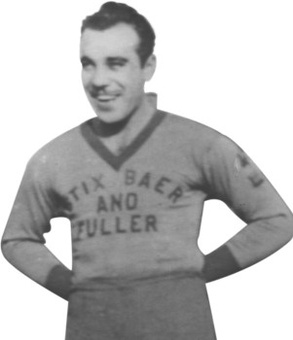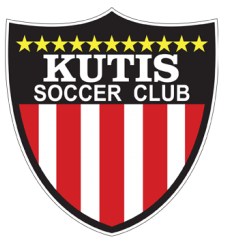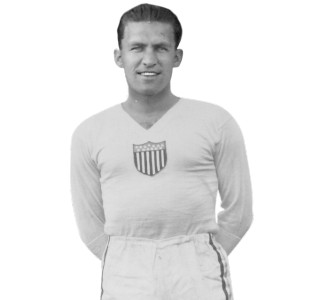Related Research Articles

Adelino William Gonsalves was an American soccer player, sometimes described as the "Babe Ruth of American Soccer". He spent over 25 years playing in various American professional leagues and was a member of the U.S. squad at the FIFA World Cup in 1930 and 1934. He is a member of the National Soccer Hall of Fame.
Harry Joseph Keough was an American soccer defender who played on the United States national team in their 1–0 upset of England at the 1950 FIFA World Cup. He spent most of his club career in his native St. Louis, winning a national junior championship, two National Challenge Cup and seven National Amateur Cup titles. He coached the Saint Louis University men's soccer team to five NCAA Men's Soccer Championships. The Keough Award, named after him and his son Ty Keough, is presented each year to the outstanding St. Louis-based male and female professional or college soccer player.
Bill Looby was an American soccer forward who spent his entire career in the St. Louis Leagues. He was a member of the U.S. Olympic soccer team at the 1956 Summer Olympics and earned eight caps, scoring six goals, with the United States men's national soccer team between 1954 and 1959. He was a member of the 1959 Bronze medal Pan American Team scoring 6 goals in those games as well. Looby is a member of the Saint Louis Soccer Hall of Fame and the National Soccer Hall of Fame.

St. Louis Kutis Soccer Club, better known as St. Louis Kutis, is an amateur American soccer club in St. Louis, Missouri. Founded in 1947 as the "St. Louis Raiders", the club was known as "Paul Schulte" during the 1948–49 season, "McMahon's" during the 1949–50 season and "Zenthoefer's" in the 1950–51 season. In 1953, the team was renamed "St. Louis Kutis". The club gained its greatest prominence in the 1950s when it dominated both St. Louis and national soccer competitions. In 1958, the United States Soccer Federation used Kutis, with a few guest players, as the U.S. national team in two World Cup qualifying matches.
St. Louis Simpkins-Ford(also known as Simpkins) was a U.S. amateur soccer team based in St. Louis, Missouri from 1947 to 1956. It won three league championships and the 1948 and 1950 National Challenge Cups, and lost in the finals of the 1954 National Amateur Cup. Five members of the U.S. team at the 1950 FIFA World Cup came from Simpkins.

Stix, Baer and Fuller F.C. was a U.S. soccer club which played in the St. Louis Soccer League from 1931 to 1934. The team was known as Hellrungs from 1929 to 1931, St. Louis Central Breweries F.C. from 1934 to 1935 and St. Louis Shamrocks from 1935 to 1938. During its short existence, it won two National Challenge Cup titles and two league championships as Stix, Baer and Fuller and one National Cup and league title as St. Louis Central Breweries.

Werner "Scotty" Nilsen is a former Norwegian American soccer forward. He is one of the highest scoring players in U.S. soccer history, scoring 131 goals in 239 games with the Boston Soccer Club. He won five consecutive National Challenge Cups during his career, and four doubles. He also earned two caps with the United States in 1934, one at the 1934 FIFA World Cup. He is a member of the National Soccer Hall of Fame.
Joseph Martinelli was an American soccer forward. Martinelli spent thirteen seasons in the American Soccer League and earned three caps with the U.S. national team in 1937.
Fabriciano “Fabri” Salcedo was a U.S. soccer forward. Salcedo spent thirteen seasons in the American Soccer League, leading the league in scoring three of those seasons, one season in the St. Louis Soccer League and part of one season in the National Soccer League of Chicago. He is a member of the National Soccer Hall of Fame.

William Stewart Lang was a Scottish-born American soccer player. A dominant player through the 1930s and a member of the U.S. national team at the 1934 FIFA World Cup, McLean disappeared without a trace in 1938. His disappearance remained a mystery until June 2022, when an investigation by The Athletic's Pablo Maurer and Matt Pentz uncovered the details behind that disappearance; McLean had suffered a nervous breakdown after multiple head injuries and lived out the last 40 years of his life in a series of public mental health facilities.
William Lehman was an American soccer half back who was on the U.S. roster at the 1934 FIFA World Cup. He played professionally in the St. Louis Soccer League.
The St. Louis Soccer League was based in St. Louis, Missouri and existed from 1915 to 1938. At its founding, it was the only fully professional soccer league in the United States. The league was founded from two teams from the St. Louis Soccer Football League and two teams from the Federal Park Soccer League.
Ben Millers was a U.S. soccer club sponsored by the Ben W. Miller Hat Company of St. Louis, Missouri. Founded in 1913, it entered the St. Louis Soccer League two years later, winning seven league titles and one National Challenge Cup before its disbandment in 1935.

Alexander McNab was a Scottish-American soccer player and coach. He began his career in Scotland before moving to the United States. In the US, he won six consecutive National Challenge Cups with teams from both the American Soccer League and St. Louis Soccer League. He was inducted into the National Soccer Hall of Fame in 2005.
James Dunn was an American soccer forward who spent nine seasons with Ben Millers in the St. Louis Soccer League and was inducted into the National Soccer Hall of Fame in 1974.
Jimmy Roe was a U.S. soccer inside left who spent his entire career in the St. Louis leagues. He was called into the national team in 1937, but suffered a career ending knee injury before his first game with the team. He was inducted into the National Soccer Hall of Fame in 1997.
Robert Paton Gregg was a Scottish football fullback who played professionally in Scotland, Canada and the United States, including the American Soccer League and St. Louis Soccer League.
Billy Watson was a Scottish-American soccer left half. He began his career in Scotland before moving to England and then the United States where he played in both the American Soccer League and St. Louis Soccer League.
The 1935-1936 St. Louis Soccer League season saw multiple attempts by league officials to find a stable line up of teams. Throughout the season, the number of teams varied with the league resuming play several times. This led to several different standings.
Soccer in St. Louis, which dates from 1882, includes pro, college, select and prep soccer teams in St. Louis, Missouri, collectively forming one of the nation's richest municipal soccer heritages.